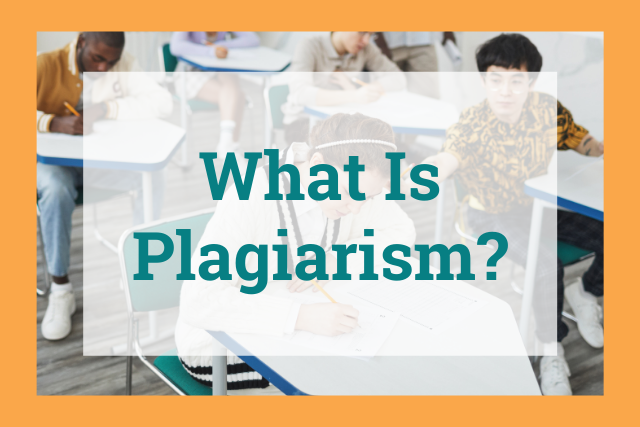
If you’re writing a paper and need to include information from external texts, you must acknowledge the source of that text. Properly formatted acknowledgments keep your work honest, ethical, and credible.
Plagiarism occurs when you include someone else’s words in your work, but don’t acknowledge or give that author the proper credit.
Plagiarism Definition
According to Merriam-Webster, to plagiarize is to “steal and pass off (the ideas or words of another) as one’s own” or “to use (another’s production) without crediting the source.”
Using someone else’s work is an act of theft.
The second entry in Merriam-Webster’s definition of plagiarism is “to commit literary theft and present as new and original an idea or product derived from an existing source.”
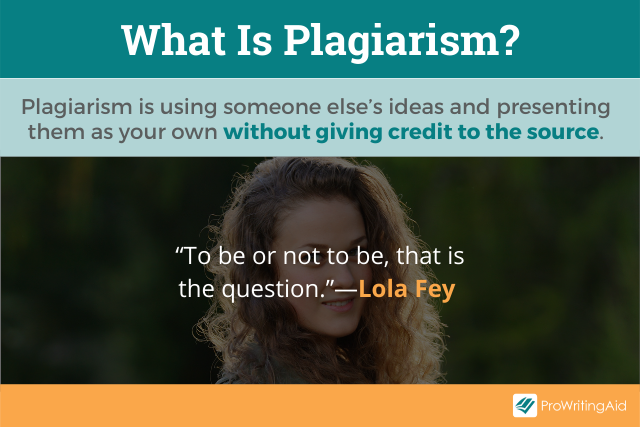
Plagiarism Meaning
When you use someone else’s ideas and present them as your own, you are stealing their intellectual property and the credit they should receive for it.
Think of a time when you told someone a joke and then heard them retell it, passing it off as their own. You were informally plagiarized, which probably left you feeling annoyed.
However, passing off someone else’s words or ideas—whether they were published or given in a speech—is serious. It’s an act of plagiarism that isn’t funny at all.
Did you notice we included quotation marks around each of the definitions given above, and that the author, Merriam-Webster’s dictionary, is acknowledged? Those quotation marks indicate the words within them are copied word-for-word from their source. Since Merriam-Webster created that definition, naming them as the author gives them their due credit.
The quotation marks and acknowledgement ensure that we have not plagiarized because we are not passing off someone else’s words or ideas as our own.
Types of Plagiarism
There are two major categories for plagiarism: intentional and accidental.
Intentional plagiarism is done on purpose, with the plagiarist’s full awareness.
With accidental plagiarism, the creator did not intend to steal or pass off others’ work as their own. It is caused by a lack of understanding of plagiarism, a lack of awareness of original work, or a lack of knowledge about how to cite properly.
Within both categories, there are six types of plagiarism.
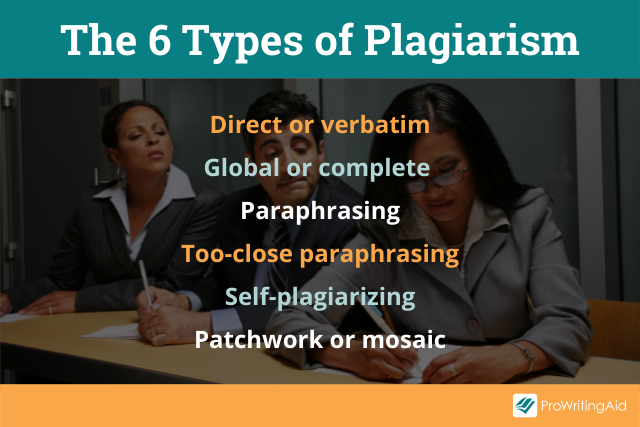
Direct or verbatim: Copying text from an original source, word-for-word, without proper punctuation and acknowledgement.
Global or complete: Having someone else write your entire paper for you, either for free or for money, and submitting it as your own.
Paraphrasing: Putting someone else’s words into your own words without acknowledging the original author.
Too-close paraphrasing: You change some of the original words in a text, but do not completely paraphrase the segment. While you might acknowledge your author, you fail to acknowledge that most of the paraphrase is directly copied from the original, but without quotation marks.
Self-plagiarizing: Reusing segments, or all, of your previous work and submitting it as new work.
Patchwork or mosaic: Taking segments of different sources and “stitching” them together to form “your” completed work, without acknowledging original sources.
Patchwork is similar to direct plagiarism, but the writer may add some transitions or connections into the work as they arrange it.
Examples of Plagiarism
To demonstrate the types of plagiarism in action we will use a segment from the article “How to Succeed at Failure,” in which author Arthur C. Brooks discusses the most productive ways to respond to failure.
Original
“Rather than protecting you from future disappointment, a cycle of rumination after failure can set you up for more failure, or at least missed opportunities to succeed. Brooding over a defeat has been found to lead to avoidance and reluctance to try something new.”
Plagiarism Example 1
Don’t dwell on a failure. Brooding over a defeat has been found to lead to avoidance and reluctance to try something new, so you need to think more positively.
Plagiarism Example 2
Don’t dwell on a failure. “Brooding over a defeat has been found to lead to avoidance and reluctance to try something new,” so you need to think more positively.
What’s wrong? Both examples include direct plagiarism. In Example 1, there are no quotation marks around the copied information, nor is the source of the article acknowledged. In Example 2, the quotation marks are present, but the source is not named.
Corrected Version
Don’t dwell on a failure. “Brooding over a defeat has been found to lead to avoidance and reluctance to try something new,” (Brooks) so you need to think more positively.
This parenthetical citation represents MLA format. Since the article is from an online publication and doesn’t include page numbers, only the author’s last name is required.
Plagiarism Example 3
Instead of protecting you from subsequent disappointment, a cycle of pondering after failure can set people up for continued failure.
What’s wrong? This is an example of “too-close paraphrasing.” Switching out synonyms is not a legitimate way to paraphrase because it often ends up sounding awkward. It’s not fair to claim the rewrite as your own words because many of the words are unchanged.
Corrected Version
Brooks states that it’s important to avoid dwelling on failure. Such thinking does nothing to protect you from further failure. In fact, it makes it more likely that you’ll experience failure again.
It is acceptable to keep some of Brooks’ keywords in your rewrite as long as you surround them in quotation marks.
Corrected Version 2
Brooks states that it’s important to avoid “brooding” over a failure. “A cycle of rumination,” he says, can actually lead to further failure.
What About Common Knowledge?
Common knowledge is information the average person would know without having to look it up.
This includes well-known historical dates (The Battle of Hastings occurred in 1066), mathematical truths (2+2=4), or scientific facts (water comprises one oxygen and two hydrogen atoms).
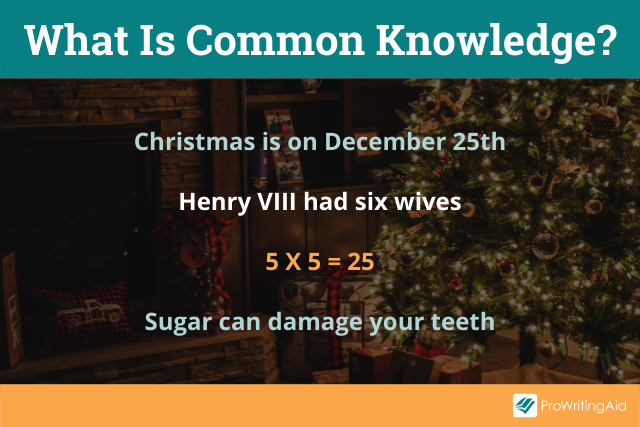
Sometimes, it’s hard to determine if something is common knowledge or if it needs to be cited. When in doubt, always cite your source.
Why Is Plagiarism Bad?
There are several reasons why plagiarism is bad, both for the plagiarist and the plagiarized. Plagiarism is unethical, fraudulent, destructive, consequential, and easy to spot.
1. Unethical
Plagiarism is unethical because it’s an act of theft. It is also an act of cheating which provides unfair and undeserved benefits to the cheater.
Plagiarists boost “their” work and benefit unjustly, perhaps through a good grade, job opportunity, or professional recognition.
2. Fraudulent
Audiences may mistakenly regard a plagiarist as an authority on a topic. Trusting the expertise of such a fraud could lead to serious consequences, especially in the medical industry.
3. Destructive
Students who plagiarize in their academic writing sabotage their own learning. Academic assignments develop skills in critical thinking, creativity, and synthesis, but students who plagiarize don’t develop those skills.
The main purpose of school is to learn; there is little point attending if you will not engage in the learning process. Plagiarism also damages the academic integrity of the plagiarist.
If you have brilliant, original ideas in your work, but supplement them with plagiarized information, you risk losing your reputation when the plagiarism is discovered.
4. Consequential
Plagiarism may cost more than your reputation. Students can face serious penalties from their instructors and academic institutions for plagiarism. The most common penalties are a failing grade, or even expulsion.
As a professional, you may face consequences from your employer or peers, like a demotion or a summary dismissal on the basis of gross misconduct.
Most seriously, some plagiarism is a form of copyright infringement. In these cases, the plagiarist may find themselves in court and out of pocket.
5. Easy to Spot
While technology has made it easier to plagiarize—copying and pasting only takes seconds—it has also made it easier to catch.
If an editor, reader, or teacher is suspicious of a particular passage, a quick Google search of a segment of the text can reveal the original source—and the plagiarism.
Most schools have platforms for student submissions that include plagiarism detection. Even without this, it might surprise you how easily teachers can detect plagiarism.
They quickly get a sense of your writing voice and abilities and recognize when something sounds “off.”
How to Avoid Plagiarism
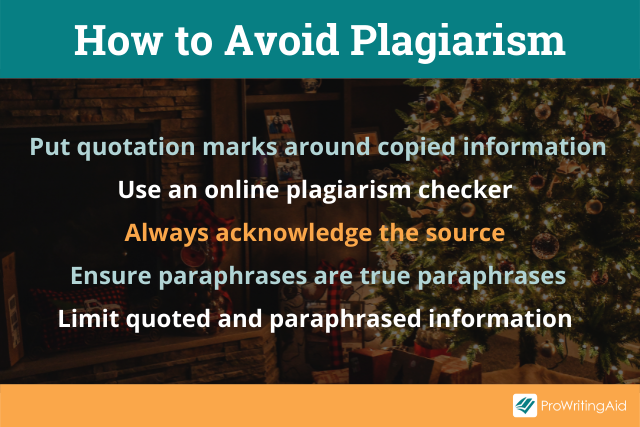
Plagiarism is unethical and can generate serious consequences. However, avoiding plagiarism is easy if you remember five basic principles.
- Put quotation marks around information you copied directly from the original source.
- Use an online plagiarism checker like ProWritingAid’s. Unlike many free plagiarism checkers, ProWritingAid does not save, share, or resell your work. It checks your work against more than a billion sources to help you confirm you have not unintentionally plagiarized.
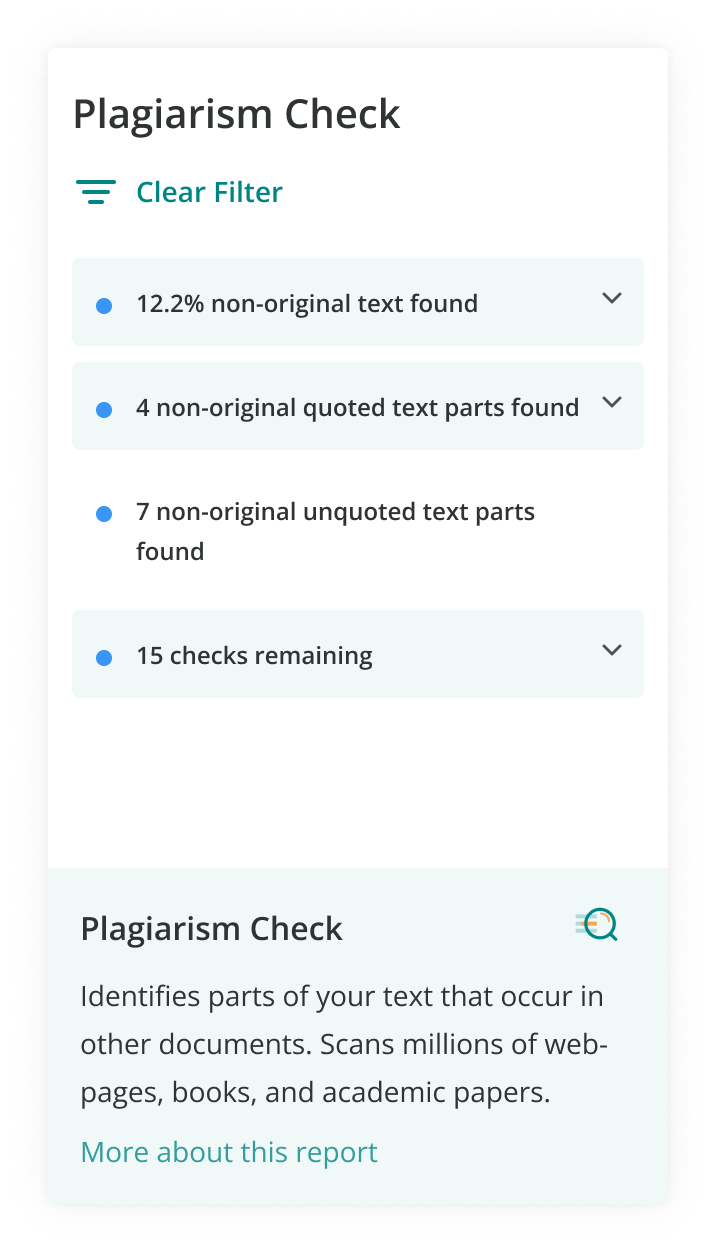
- Always acknowledge the source (or sources) of your direct quotes or paraphrased information.
- Make sure that paraphrases are true paraphrases, not just direct quotes with a few switched out words.
- Use quoted and paraphrased information as part of your paper, not the whole paper. Borrowed information should support, provide evidence for, elaborate on, or strengthen your content. It should never be your entire paper.


